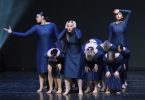“It takes an athlete to dance, but an artist to be a dancer.” – Shanna La Fleur
This quote causes us to pause and look differently at dancers and their abilities. While it is true that dancers often transcend reality into a world of make-believe similar to those in the theatre, it is also pointed out that dancers train for hours to achieve the incredible feats their bodies perform, similar to the training recreational and competitive athletes undertake.
Understanding dancers as athletes begins in the dance studio where dancers train. Whether the ritual dance class begins at the ballet barre, standing or sitting in the center of the studio, the dancer-athlete subjects their body to countless hours of classes, repeating over and over the basic movements that are the foundation of every dancer’s training. This repetition breeds strong artists and athletes who are able to compete and perform at a very high level.
We refer to this basic foundation with the analogy of building blocks. As a child builds a tower with blocks, they must construct from the bottom up, carefully stacking and placing subsequent blocks on top with patience and precision. So, too, does the dancer, who stacks and builds their technique by repeating finely-tuned physical skills that, together in combination with the artistry of choreography, combine to create beautiful dance works.
Classical ballet provides the foundation for all other dance forms. It is the most demanding and most disciplined of all dance forms, but it is also the most rewarding. With a solid ballet foundation, classically-trained dancers can transfer their skills into jazz, modern/contemporary dance, or any other dance form they might decide to pursue.
This aesthetic, though, is achieved at a price. Dancers suffer from a number of chronic and acute injuries that, if not addressed, can delay progress, lead to compensatory injuries or even end careers. It is important to look at dance differently than sport, but to also acknowledge the similarities that exist in the training of both the athlete and the dancer.
www.danceextreme.com







